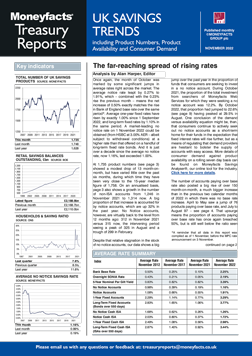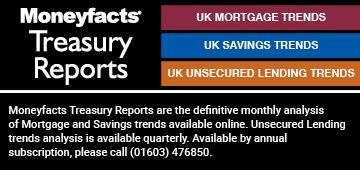Rachel Springall, Finance Expert at Moneyfacts, said:
“Interest rates have continued to rise across the savings spectrum, and we witnessed nine consecutive months of increases to all average rates for the first time on our records. The average easy access rate breached 1% for the first time in over 10 years and fixed rate bonds saw the average shelf life fall to 26 days, the lowest figure seen since 2009. These highlights are proof of the positive direction of the cash savings market, with further rises expected due to the Bank of England base rate rises.
“Challenger brands have continued to be a notable catalyst for fuelling the fixed bond market with further improvements month-on-month, with the average rate for one-year bonds breaching 3% for the first time since November 2009 and standing at its highest point since January 2009. The average longer-term fixed rate also rose to its highest point since February 2010, but considering consecutive rises in interest rates, whether savers are prepared to lock away their cash for longer than a year is debatable. The market may then continue to see volatility for shorter-term bonds and the shelf life of fixed bonds in the months to come.
“ISA rates have continued to increase, with fixed rates rising to levels not seen in a decade and variable rates rising to the highest levels since 2013. These are encouraging signs for savers who wish to utilise their ISA allowance, especially those with larger pots who may be edging closer to their Personal Savings Allowance (PSA) limit due to rising interest rates. However, it remains the case that the rate gap between fixed ISAs and bonds is obvious, so savers will need to weigh up any tax-free allowance they have before they commit.
“As the cost of living crisis continues, having quick access to cash could be invaluable and accounts such as an easy access account can offer that flexibility. According to the Bank of England, there was an inflow of just over £3 billion into interest-bearing sight deposits in September, showing consumers are still putting money away into flexible accounts, but there was also an inflow of £3.3 billion into time deposits – a sign of consumers taking advantage of the significant rises to fixed rates in recent months. As the savings market remains volatile, consumers and providers will need to act swiftly to keep on top of any prominent offers.”
Rachel Springall, Finance Expert at Moneyfacts, said:
“Interest rates have continued to rise across the savings spectrum, and we witnessed nine consecutive months of increases to all average rates for the first time on our records. The average easy access rate breached 1% for the first time in over 10 years and fixed rate bonds saw the average shelf life fall to 26 days, the lowest figure seen since 2009. These highlights are proof of the positive direction of the cash savings market, with further rises expected due to the Bank of England base rate rises.
“Challenger brands have continued to be a notable catalyst for fuelling the fixed bond market with further improvements month-on-month, with the average rate for one-year bonds breaching 3% for the first time since November 2009 and standing at its highest point since January 2009. The average longer-term fixed rate also rose to its highest point since February 2010, but considering consecutive rises in interest rates, whether savers are prepared to lock away their cash for longer than a year is debatable. The market may then continue to see volatility for shorter-term bonds and the shelf life of fixed bonds in the months to come.
“ISA rates have continued to increase, with fixed rates rising to levels not seen in a decade and variable rates rising to the highest levels since 2013. These are encouraging signs for savers who wish to utilise their ISA allowance, especially those with larger pots who may be edging closer to their Personal Savings Allowance (PSA) limit due to rising interest rates. However, it remains the case that the rate gap between fixed ISAs and bonds is obvious, so savers will need to weigh up any tax-free allowance they have before they commit.
“As the cost of living crisis continues, having quick access to cash could be invaluable and accounts such as an easy access account can offer that flexibility. According to the Bank of England, there was an inflow of just over £3 billion into interest-bearing sight deposits in September, showing consumers are still putting money away into flexible accounts, but there was also an inflow of £3.3 billion into time deposits – a sign of consumers taking advantage of the significant rises to fixed rates in recent months. As the savings market remains volatile, consumers and providers will need to act swiftly to keep on top of any prominent offers.”











